
Advances in Natural Sciences, Vol. 7, No. 1 & 2 (2006) (37 – 47)
Materials Science
INFLUENCE OF SUBSTITUTION OF THE MAGNETIC 3d
METALS FOR Mn IN PEROVSKITE La0.67Ca0.33Mn0.90TM0.10O3
(TM = Fe, Co, Ni) COMPOUNDS
Nguyen Huy Sinh, Vu Thanh Mai, and Pham Hong Quang
Cryogenic Laboratory, Faculty of Physics, Hanoi University of Science, VNU
334 Nguyen Trai, Thanh Xuan, Hanoi, Vietnam
Abstract. Influence of substitution of 3d metals for Mn on properties of La0.67 Ca0.33 Mn0.9
TM0.1O3(TM = Fe, Co, Ni) compounds was studied. Ferromagnetic – paramagnetic and metals
– insulator transitions were significantly affected by Mn-site substitution. However, no observable
difference was found in their crystal structure from X-ray diffraction analysis. At room temper-
ature the structure characterization of these compounds gave the single phase and structure is
the distortion orthorhombic cell with space group symmetry Pnma. The magnetoresistance mea-
surement showed that the magnetoresistance ratio MR increases until 17% in magnetic field of
0.4 T, and in low magnetic field region (µoH<0.05 T), MR = 7.5% at 102 K. The investigations
of EPR showed that the intensity of resonance line can be well fitted by the expression: I(T) =
Ioexp(Ea/kBT). The values of activation energy have been determined with Ea= 0.074 eV, 0.093
eV and 0.086 eV for substituted Fe, Co, Ni samples, respectively. These values are slightly smaller
than the value of Ea= 0.12 eV for La0.67 Ca0.33 MnO3. We attribute the reason to the reduction
of Mn3+ content caused by TM substitution for Mn. The dependence transition temperatures
and transport properties of all samples are well explained by introducing the SE interaction with
considering that the Fe3+ ,Co
3+ and Ni2+ ions have high-spin configuration, the local DOS near
the Fermi level at the TM site Nx(Ef) would decrease from Ni to Co and Fe [1], thus reduces the
hopping probability and increases the resistivity in order.
1. INTRODUCTION
LaMnO3is the antiferromagnetic insulator, when it is doped with the divalent ions
(La1−xAxMnO3with A = Ca2+
,Sr2+,Ba
2+. . . ) it can be driven into a metallic ferromag-
netic state due to conversion of proportional number of Mn3+ to Mn4+ through double
exchange (DE) of Mn3+ -O
2−-Mn
4+ interaction [1]. The electronic configurations are
Mn3+ (t3
2ge1
g) and Mn4+ (t3
2ge0
g). The mobile egelectrons produced due to the hole doping
DE mediate ferromagnetism and conduction, thus the DE interaction not only controls
ferromagnetic state but also influences metal–insulator transition temperature in doped
La1−xAxMnO3compounds.
The basic structures of La1−xCaxMnO3compounds are ABO3–type perovskite, in
which A - site cations and oxygen ions form the structures frame. The B – site cation
is relatively small sized and resides in an octahedral site. The Mn and O form a basic
module of the MnO6octahedron, which plays a major role in determining the properties
of materials. The various cations in the A site produce different chemical pressures to
change the Mn–O–Mn bond angle and bond distance. It is found that the average size of
A-site cations and their size distribution have significant effects on properties of maganites
[2,3]. However, the influence of substitution on A–site is indirect to the environment of the

38 Nguyen Huy Sinh, Vu Thanh Mai, and Pham Hong Quang
MnO6octahedron structure. So, it is more interest to study the influence of substitution
of B–site (Mn), which rather direct to extend understanding in this system.
Usually, the observations showed that Mn–substitution weakens the double–exchange
(DE) interaction, but origin do not explained clearly yet. There are many reasons to be
considered upon Mn–substitution, such as structure deformation due to the size difference
between Mn–ions and substituting elements, formation of antiferromagnetic clusters by
substitution, change of electronic structure of Mn ions, different Mn3+/Mn4+ ratios, and
the magnetic nature of substituting element etc [4].
Some investigators have studied the substitution of Fe, Co, Ni for Mn in La1−xCax
Mn1−yTMyO3compounds [5–7]. It is found that only the Mn egband is electronically
active, where electron hopping between the Mn3+ and Mn4+ ions is happened. Since TM
replaces Mn, it reduces the Mn3+/Mn4+ ratio and reduces the number of available hoping
sites. Thus the DE is suppressed, resulting in the reduction of ferromagnetic exchange
and metallic conduction. Some authors show that in the low temperature range, the spin
– glass type of behaviors and antiferromagnetic clusters occurred [5, 8].
In this report we show our results of examinations on properties of compounds
La0.67Ca0.33Mn0.90TM0.10O3(TM = Fe, Co, Ni) to extended understanding the role of
substituting elements in the system.
2. EXPERIMENTAL
The samples of La0.67Ca0.33Mn0.90TM0.10O3(TM = Fe, Co, Ni) were prepared by
solid state reaction method. Starting high-purity compositions of La2O3, CaCO3, MnO
and transition metal oxides of CoO3,Fe
2O3, NiO were mixed and grounded for 2 hours.
The mixed powders were dried at 2000C for 2 hours and pressed into pellets. The pellets
were first presintered at 1000C for 2 hours, at 8000C for 24 hours and then cooled down to
room temperature by the furnace turning off. After that, the pellets were grounded about
one hour to collect particles smaller than 100µm and pelletized again. A multi-steps proce-
dure is applied for the heat treatment of the samples. The samples have been investigated
by X–ray powder diffraction (XPD), magnetization, energy dispersive spectrum (EDS),
oxygen concentration, resistivity, magnetoresistance and electron paramagnetic resonance
(EPR) measurements.
3. RESULTS AND DISCUSSION
3.1. Crystal structure investigations
The XPD patterns of La0.67Ca0.33Mn0.90TM0.10O3(TM = Fe, Co, Ni) in Fig. 1
showed that all samples are single phase with a perovskite structure. All reflections could
be indexed on the basis of the distortion orthorhombic cell with space group symmetry
Pnma. The values of the lattice parameters and cell unit volume of the samples were
shown in Table 1.
It indicated that with amount of substitution of 10% at Fe3+,Co
3+ and Ni2+ the
lattice parameters and cell unit volume very slightly decreased in comparison with those
of the undoped sample. The reason is that the radii of Fe3+,Co
3+, and Ni2+ (0.56
˚
A; 0.61 ˚
A; 0.69 ˚
A, respectively) are close to the radius of Mn3+ (0.65 ˚
A). It may be
supposed that in range of low doping concentration, the formation of crystal structure
of La0.67Ca0.33Mn0.90TM0.10O3−δ(TM = Fe, Co, Ni) is nearly unchanged in comparison

Influence of Substitution of the Magnetic 3d Metals for Mn in Perovskite ... 39
Table 1. Values of the lattice parameters of La0.67Ca0.33Mn0.90TM0.10O3−δ(TM
= Fe, Co, Ni)
Samples a(˚
A) b(˚
A) c(˚
A) V(˚
A3)
La0.67Ca0.33MnO35.483 7.728 5.471 231.82
La0.67Ca0.33Mn0.90Fe0.10O3−δ5.442 7.696 5.436 227.67
La0.67Ca0.33Mn0.90Co0.10O3−δ5.434 7.687 5.425 226.82
La0.67Ca0.33Mn0.90Ni0.10O3−δ5.447 7.717 5.438 228.58
Fig. 1.The XPD patterns of La0.67Ca0.33Mn0.90TM0.10O3(TM = Fe, Co, Ni)
with pristine material La0.67Ca0.33MnO3[9]. The EDS spectra showed that the actual
components of the samples as La, Ca, Mn, Fe, Co and Ni were indicated in Figs. 2a, 2b
and 2c, respectively. There are no any impurities index in these compounds.
The surface structure of the samples obtained by SEM measurement is shown in
Fig. 3a, 3b, 3c. It is found that the size, shape and distribution of the grains on the surface
of the samples are homogeneous. The grain size and distribution of the grains are not so
much changed. It may be seen a little difference between grains of the Fe, Co and the Ni
samples. We can suggest the season is that the ion radii of Fe3+,Co
3+ are similar to that
of Mn3+ but that of Ni2+ is smaller. This means the crystal structure of all the samples
nearly unchanged.
The oxygen deficiency (δ) in these compounds has been determined by Dicromat
method. From obtained oxygen concentration, the ions of Mn3+ and Mn4+ as the ratio of
Mn3+/Mn4+ were estimated (see Table 2).
In this case it can be expected free ion values of La0.67Ca0.33Mn0.9TM0.1O3−δ(TM
= Fe, Co, Ni) are 58% of Mn3+; 31% of Mn4+; 10% of Fe3+ for TM = Fe 48% of Mn3+;
42% of Mn4+; 10% of Co3+ for Co and 49% of Mn3+ ; 40% of Mn4+ and 10% of Ni2+ for
x = Ni, respectively. While the free ion values are 67% of Mn3+ and 33% of Mn4+ in
La0.67Ca0.33MnO3.
Thus, the ratio of Mn3+/Mn4+ in the doped Fe, Co, Ni sample is smaller than that
of undoped samples. It strongly implies that DE model alone cannot explain the effect of
the transition metal substitution. When Mn ions are substituted by TM (TM = Fe, Co,

40 Nguyen Huy Sinh, Vu Thanh Mai, and Pham Hong Quang
Fig. 2.The EDS spectra of La0.67Ca0.33Mn0.90TM0.10O3(TM = Fe, Co, Ni)
Ni) we should consider the existence of metal–oxygen bonding TM–O–Mn and TM–O–TM
but the number of TM ions/ Mn ions should be statistically greater than 17% to find the
TM–O–TM bond [5]. In these compounds, the amount of TM ions is only 10% ats and
the probability of the TM–O–TM bond is low. Thus, it may assume that the TM–O–Mn
bond is the disturbance only. This is made that TM and Mn ions interact by way of
the superexchange (SE) mechanism. This is supposed that, because more Mn3+ became
Mn4+ in TM- substituted compounds, the competition between DE and SE mechanism

Influence of Substitution of the Magnetic 3d Metals for Mn in Perovskite ... 41
Table 2. The oxygen deficiency (δ), concentration and the ratio of Mn3+ and
Mn4+ ions
Samples δMn3+ Mn4+ Mn3+/Mn4+
Undoped LCMO 0.67 0.33 2.00
Doped-Fe 0.0106 5.879 0.3121 1.88
Doped-Co 0.0079 0.4825 0.4175 1.16
Doped-Ni 0.0140 0.4947 0.4053 1.22
Fig. 3.The SEM images of La0.67Ca0.33Mn0.90TM0.10O3(TM = (a)Fe, (b) Co,
(c) Ni).
more strongly leading that SE rather strong than DE in substituted transition metal
system. Thus the SE-mechanism will dominant in TM-O-Mn bond interaction when ratio
of Mn3+/Mn4+ decreases, therefore the ferromagnetic configuration has been formed.
3.2. Magnetization and resistivity
The magnetization versus temperature is shown in Fig. 4. From these curves, the
Curie temperature has been determined. Our obtained results are 270 K, 135 K, 160 K
and 165 K for LCMO, LCMFeO, LCMCoO and LCMNiO, respectively.
This clearly showed that with substitution of Fe, Co, Ni for Mn in the La0.67Ca0.33MnO3
the Curie temperatures (TC) strongly decrease. It agrees with results of the authors [5]
for example.
If the substitution of Fe, Co, Ni for Mn with only 5% at, the Curie temperature de-
creases from 271K for LCMO to 181K, 214K and 226K for LCMFeO, LCMCoO and LCM-
NiO, respectively. It can be suggested that when increasing substituted content ats of TM-
metal, the Curie temperature more strongly depressed than that of La0.67Ca0.33MnO3.
The resistivity measurements have been carried out on these samples in zero and
0.4T magnetic fields. In case substitution of Fe and Co, the maximum in resistance curves
are disappeared and resistance curves increased with decreasing temperature (Fig. 5).
Magnetoresistance
The application of a magnetic field of 0.4 T displaces the resistance maximum to-
ward higher temperature from 125 K at H = 0 to 131 K at H = 0.4 T for Ni-substitution,
as shown in Fig. 6. We supposed that displacing to higher temperature the metal-
semiconductor (M-SC) transition is due to with increasing field near the ferromagnetic-
paramagnetic transition, ferromagnetism is favored over paramagnetism. Consequently,

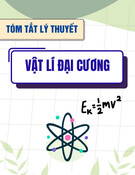

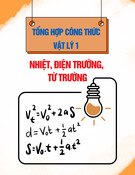

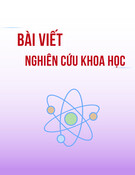


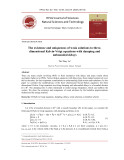
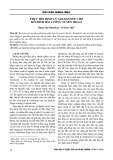
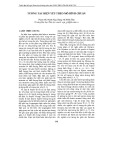








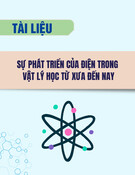
![Bộ câu hỏi lý thuyết Vật lý đại cương 2 [chuẩn nhất/mới nhất]](https://cdn.tailieu.vn/images/document/thumbnail/2025/20251003/kimphuong1001/135x160/74511759476041.jpg)
![Bài giảng Vật lý đại cương Chương 4 Học viện Kỹ thuật mật mã [Chuẩn SEO]](https://cdn.tailieu.vn/images/document/thumbnail/2025/20250925/kimphuong1001/135x160/46461758790667.jpg)




